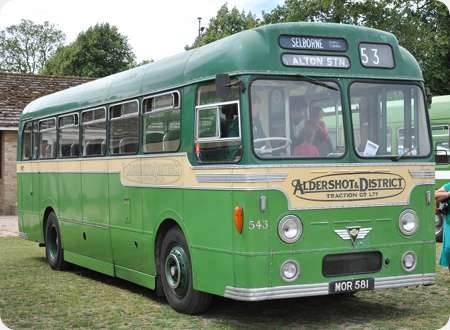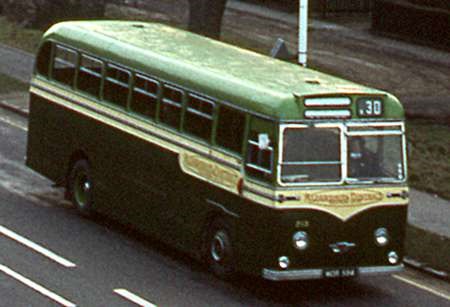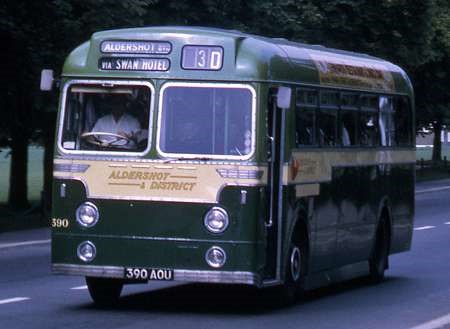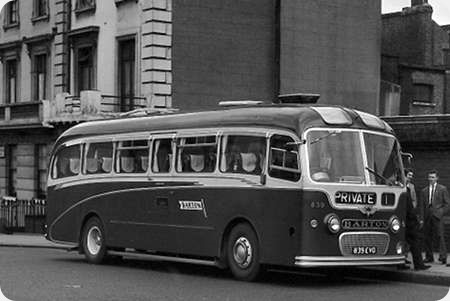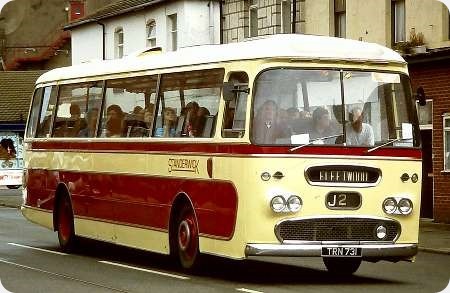Aldershot & District – AEC Reliance – MOR 581 – 543
Aldershot & District Traction Co
1954
AEC Reliance MU3RV
Metro-Cammell B40F
MOR 581 is an AEC Reliance MU3RV. The chassis of this Aldershot & District vehicle dates from 1954, but the body we see ("MCW" in the PSVC listings) was fitted in 1967. The seating is of the B40F layout, and we see it in the Alton Rally on 18 July 2010. One unfortunate feature of the Alton Rally and Fleetwood Tram Sunday is that they often clash and, even with what some of my former colleagues used to call an ‘optimistic’ style of driving, even I can’t manage both in the day!
Photograph and Copy contributed by Pete Davies
05/12/16 – 09:36
Beautiful! I used to travel on these, and their cousins with the older style of bodywork with an opening window for the driver. One A&D feature on OPO buses was to have just a single seat on the front nearside to allow more room for passengers paying the driver, but at the time I was a regular traveller, these buses were crew-operated. My memories are of the No.19 which turned up on time every weekday morning to take me to Haslemere Station and then onto a train to Waterloo. The railway part of my journey was much less reliable until the elderly pre-war 4-CORs were replaced by 4-CIGs.
David Wragg
06/12/16 – 14:03
Does anyone know if others of the batch were given new bodies, or why this one was treated? Crash damage springs to mind . . .
Pete Davies
06/12/16 – 15:43
Pete,
I seem to recall that there were quite a number of them and one bus magazine, it may have been ‘Passenger Transport’ commented that it was surprising that such a dated style was being adopted. I take their point, but I actually liked this style.
David Wragg
07/12/16 – 06:32
Thank you for that, David.
Pete Davies
07/12/16 – 06:34
According to this 15 of them were re-bodied in ’67 //www.sct61.org.uk/ad267a
Here is another re-bodied one //www.sct61.org.uk/ad273
John Lomas
07/12/16 – 06:36
In its search for a suitable vehicle of the then new underfloor engined format, Aldershot & District initially bought a Dennis Dominant in 1951. Only three Dominant chassis were ever made, of which two were bodied, the third chassis being dis-assembled after exhibition at the 1950 Earls Court Show. Although Dennis abandoned plans for volume production of the model, there was very little wrong with the Dominant apart from its excessive weight (a characteristic shared by the the contemporary Regal IV and Royal Tiger), and Aldershot & District kept HOU 900 in front line service for fourteen years. In 1953 the company bought a solitary example of the Guy Arab LUF, which it retained in service until 1965, but purchased no more. Then, after sampling a number of different underfloor types, Aldershot & District finally took the plunge in 1954 with the AEC Reliance, twenty five being delivered with rather gawky, high floor and waistline, Strachans Everest C41C bodywork. These were registered MOR 581 to 605, numbered 250 to 274, and were used on the Farnham – London express route, and on excursions and private hire until displaced by the 1963 Park Royal bodied Reliances. These Strachans MU3RV coaches were powered by the small AH 410 engine of 6.754 litres, a direct (though updated) descendant of the A172 “bootlace” wet liner engine of the 1935 Regal II. The "bootlace" engine design became the basis for all the AEC wet liner engines from the 1950s, and therein lay the root of subsequent trouble, for the original “bootlace” became notorious for cylinder liner seal and gasket failures. No. 263, MOR 594 is shown in 1968 on route 3D (Aldershot – Cove, Minley Estate) passing the RAE in Farnborough Road. The inadequate destination blind display seen here was most unusual on A&D in those days, and indicates a degree of crew laziness in the early NBC era that would not have been tolerated in BET times. These machines were quite pleasant to drive, though given to a somewhat wallowy standard of ride, but the performance with the small AH410 engine was less than sparkling. In 1965, fifteen of these coaches were selected for rebodying with the then A&D standard Weymann saloon design, but the Weymann factory was closing down, and the order was undertaken by Metro-Cammell. The engineering standards on Aldershot & District were extremely high, and no doubt all of the initial 25 Reliances could have been so rebodied if required. Indeed, the remaining Strachans vehicles, of which No. 263 shown was one, continued in service for several more years.
After experience with the initial Strachans bodied coaches, from 1957 Aldershot & District adopted the AH 470 engined Reliance as its standard saloon type with Weymann B41F (OMO) or B43F bodies. The initial buses had opening windscreens for the driver, but the 1960 and subsequent batches incorporated fixed windscreens which had just become legal. No.390, 390 AOU was a 2MU3RV vehicle of 1961, and representative of the final style of the Weymann A&D saloon. It is seen in Queens Avenue, the technically military road that links Farnborough North Camp with Aldershot, and is wearing the revised saloon livery of 1967 with the darker green on the lower panels. It is also carrying the retrograde ‘simplified’ fleetname style that appeared in that same year. The Metro-Cammell bodies on MOR 581 above and some new 1966/67 Reliances differed from the Weymann version in several respects – the offside emergency exit was placed at the rear instead of the centre, the front screens lacked the metal surround, and the lower front panel incorporated a small grille.
Roger Cox
07/12/16 – 06:37
This was from a batch of twenty-five 250-274, MOR 581-605 new in 1954/5 with Strachans C41C bodies.
In 1965 250/2/4-7/9-62/4/9/70/2/3 were delicensed and the bodies removed. The chassis were rebuilt and were rebodied with MCW B40F bodies, renumbered 543-557 respectively, and entered service in 1967. They were to the same design as 283-312, RCG 601-630, which had been new in 1957.
Prior to 1966 bodies were built by Weymann at Addlestone and by Metro-Cammell in Birmingham but after the Weymann works closed at the end of 1965 all subsequent bodies were built by Metro-Cammell-Weymann.
John Kaye
07/12/16 – 13:33
Many thanks for your further thoughts on the history of this vehicle and her sisters.
Pete Davies
07/12/16 – 16:34
I can remember seeing the AEC Reliance chassis parked in the Guildford garage all painted in bright silver paint, I assume they were waiting to be sent for rebodying. I was a passenger on an A & D Loline 111 service 20 travelling from Aldershot to Woodbridge road Guildford to attend technical college.
John Shrubb
10/12/16 – 17:28
I’ve been thinking (I do occasionally!) and I suspect that the fifteen Strachans Reliances selected for rebodying might well have been chosen on the basis of body condition, the better ones being retained as they were. Certainly those that kept their Strachans C41C bodies continued in service for several years after 1965.
Roger Cox
